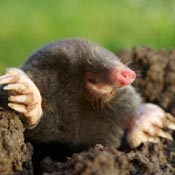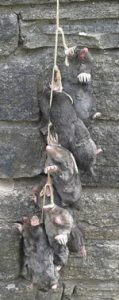Mole Biology

Talpa europaea
European moles (Talpa europaea) belong to the Insectivora, weigh about a 100 – 150 grams. A Mole need to eat about 50 grams of insects a day to maintain its high metabolic rate. Contrary to common belief, they do not have a winter hibernation period. In addition it is a very solitary animal (although a great number of can be present in fields). They feed mainly on earthworms and other invertebrates caught in their tunnel systems.
Mole hills are the most obvious sign of activity. The garden mole causes unsightly damage to lawns which is usually a reason why a mole catcher is called to homes. However, activity in agricultural land can cause serious damage to livestock and crops. For example, when grass is used for silage, soil contamination can spoil feeds, making it less palatable for livestock and increasing the risk of soil-born diseases. This is the main reason for agricultural mole elimination.
Reasons to hire a mole catcher

catch from a large rural garden
Gadgets such as ultrasound or magnetic repellents currently available are a waste of money and should be avoided as a deterrent. There is no solid scientific proof that they work.
Also, the live trapping for release elsewhere is cruel in practice, because they panic and often die of exhaustion. The best option is to get a traditional mole catcher to remove them efficiently!
Trapping Moles, Wigan, Preston, Lancashire and Merseyside
I use an arsenal of different traps including the Duffus / half barrel trap (UK), Putange trap (French), Talpex traps (Dutch), Trapline trap (US) and Fenn traps (UK) to get rid of moles. The use of a particular type of trap depends on specific circumstances. However, the aim is always to catch moles ASAP, before they do anymore damage!
In an agricultural setting I simply charge per trapped animal with no callout, survey or hidden charges. In addition, I can offer a very competitive rate per mole caught. For domestic mole control there is a simple flat trap setting fee valid for 1 month, then a charge per trapped mole.
We also offer a “bulk” discount if the mole control survey suggest that large numbers are present in an agricultural setting and you can discuss your budget. Alternatively we can offer customized scheduled re-visits to nip invasions in the bud, work at an hourly rate, or per land area covered (as opposed to a charge per mole) for farms where a large numbers are present. We catch moles in Wigan, St Helens, Ormskirk, Skelmersdale, Liverpool, Preston, Manchester, Bolton and surrounding areas. Call 0800 644 0134 or 0796 88 45 888 for price enquiries or to discuss your specific requirements.
